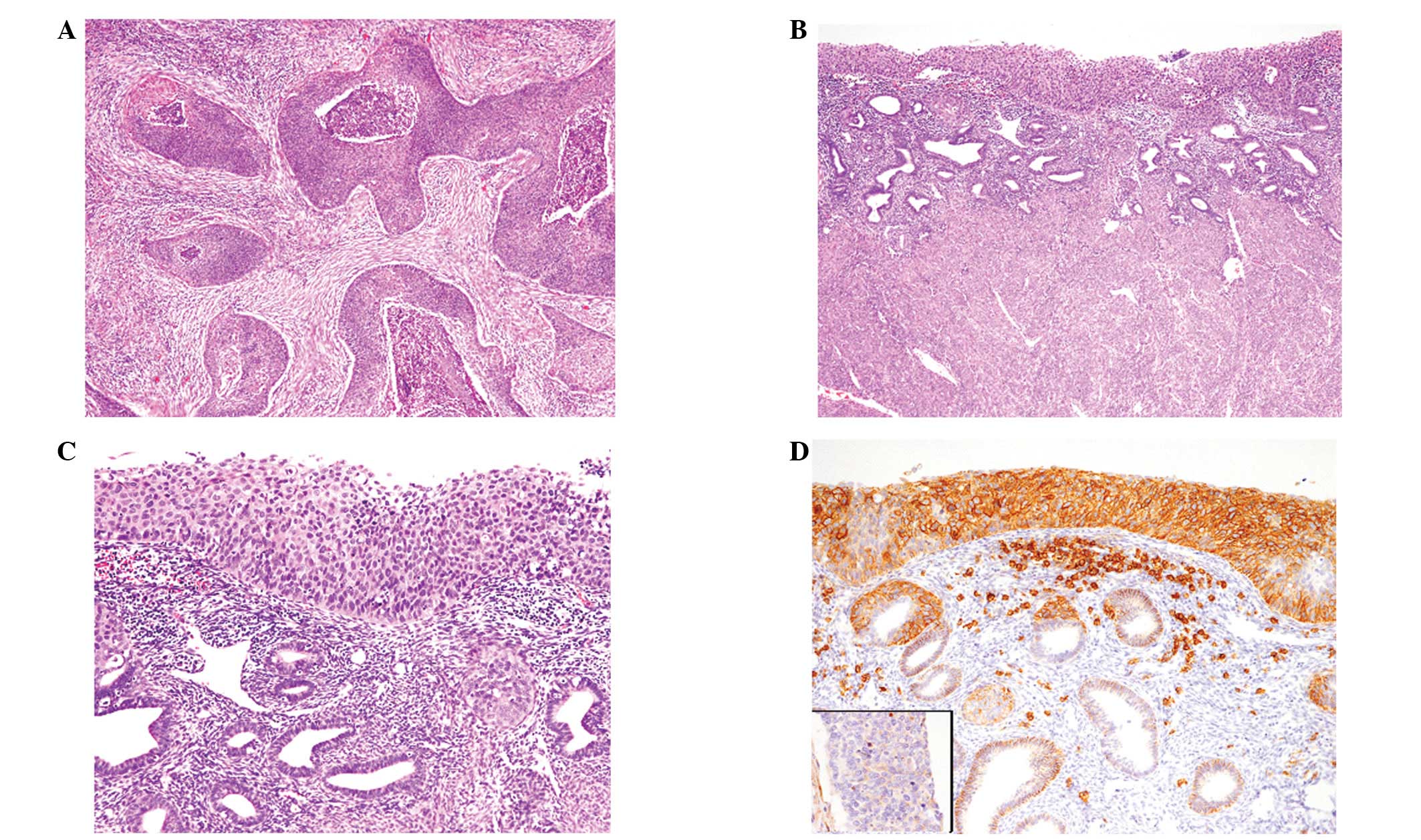Superficial spreading squamous cell carcinoma of the uterine cervix involving the endometrium: Report of two cases with emphasis on the likely molecular mechanism
- Authors:
- Mitsuaki Ishida
- Hidetoshi Okabe
-
View Affiliations
Affiliations: Department of Clinical Laboratory Medicine and Division of Diagnostic Pathology, Shiga University of Medical Science, Shiga, Japan
- Published online on: October 3, 2012 https://doi.org/10.3892/ol.2012.953
-
Pages:
31-34
Metrics:
Total
Views: 0 (Spandidos Publications: | PMC Statistics:
)
Metrics:
Total PDF Downloads: 0 (Spandidos Publications: | PMC Statistics:
)
This article is mentioned in:
Abstract
Squamous cell carcinoma (SCC) of the cervix generally invades directly into the uterine wall, but in rare cases it spreads superficially to the inner surface of the uterus, thereby replacing the endometrium. This type is called superficial spreading SCC. In the present study we report two cases of this unusual form of cervical SCC and discuss the possible molecular mechanism involved. Two females, aged 64 (case 1) and 59 (case 2) years old, presented with post-menopausal vaginal bleeding. Histopathological studies of the resected specimens revealed non-keratinizing SCC of the cervix (pTIIA1 in case 1 and pTIIB in case 2). A notable finding in the two tumors was that atypical squamous cells were extending and replacing the endometrium directly from the cervix. Glandular involvement of atrophic endometrial glands was observed, however no invasive growth was observed in the endometrium in either case. Immunohistochemical studies revealed that CD138 was strongly expressed in the carcinoma cells superficially spreading in the endometrium in the two cases. It has been reported that the loss of expression of CD138, a cell-surface heparan sulfate proteoglycan participating in cell-cell and cell-extracellular matrix interactions, is correlated with tumor invasion and progression to cervical SCC. Our present findings suggest that CD138 expression in carcinoma cells may participate in superficial spread by regulating cell-cell interactions.
View References
|
1
|
Gungor T, Altinkaya SO, Ozat M, Akbay S
and Mollamahmutoglu L: Unusual form of superficial spreading
squamous cell carcinoma of cervix involving the endometrium,
bilateral tubes and ovaries: a case report with literature review.
Arch Gynecol Obstet. 283:323–327. 2011. View Article : Google Scholar
|
|
2
|
Tan GC, Isa MR, Ng SP and Jamil MA:
Unusual form of superficial spreading microinvasive squamous cell
carcinoma of uterine cervix involving the endometrium of uterus. J
Obstet Gynaecol Res. 30:363–367. 2004. View Article : Google Scholar : PubMed/NCBI
|
|
3
|
Kushima M, Fujii H, Murakami K, et al:
Simultaneous squamous cell carcinomas of the uterine cervix and
upper genital tract: loss of heterozygosity analysis demonstrates
clonal neoplasms of cervical origin. Int J Gynecol Pathol.
20:353–358. 2001. View Article : Google Scholar
|
|
4
|
Pins MR, Young RH, Crum CP, Leach IH and
Scully RE: Cervical squamous cell carcinoma in situ with
intraepithelial extension to the upper genital tract and invasion
of tubes and ovaries: report of a case with human papilloma virus
analysis. Int J Gynecol Pathol. 16:272–278. 1997. View Article : Google Scholar
|
|
5
|
Bernfield M, Götte M, Park PW, et al:
Functions of cell surface heparan sulfate proteoglycans. Ann Rev
Biochem. 68:729–777. 1999. View Article : Google Scholar : PubMed/NCBI
|
|
6
|
Oh JH, Kim JH, Ahn HJ, et al: Syndecan-1
enhances the endometrial cancer invasion by modulating matrix
metalloproteinase-9 expression through nuclear factor kappa B.
Gynecol Oncol. 114:509–515. 2009. View Article : Google Scholar : PubMed/NCBI
|
|
7
|
Davies EJ, Blackhall FH, Shanks JH, et al:
Distribution and clinical significance of heparan sulfate
proteoglycans in ovarian cancer. Clin Cancer Res. 10:5178–5186.
2004. View Article : Google Scholar : PubMed/NCBI
|
|
8
|
Numa F, Hirabayashi K, Kawasaki K, et al:
Syndecan-1 expression in cancer of the uterine cervix: association
with lymph node metastasis. Int J Oncol. 20:39–43. 2002.PubMed/NCBI
|
|
9
|
Shinyo Y, Kodama J, Hasengaowa, Kusumoto T
and Hiramatsu Y: Loss of cell-surface heparan sulfate expression in
both cervical intraepithelial neoplasm and invasive cervical
cancer. Gynecol Oncol. 96:776–783. 2005. View Article : Google Scholar : PubMed/NCBI
|
|
10
|
Kim YI, Lee A, Lee BH and Kim SY:
Prognostic significance of syndecan-1 expression in cervical
cancers. J Gynecol Oncol. 22:161–167. 2001. View Article : Google Scholar : PubMed/NCBI
|












